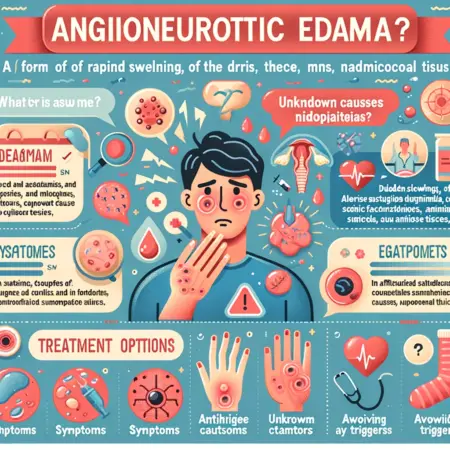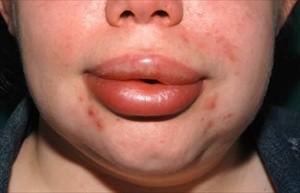Angioneurotic edema (angioedema is characterized by painless swelling in the subcutaneous tissues or submucosa. usually occurring about the face (eye*, lips, tongue’, but any part of the body may be involved. Two types are now well recognized: sporadic, transient angioedemu, related to giant urticaria but involving deeper ve M-U, caused primarily by food allergy, and hereditary angioedema, which is transmitted as an autosomal dominant trait and is marked by severe deficiency in function of an inhibitor to the activated first component of complement – C’ 1 esterase.

Etiology of Angioneurotic Edema
The causes of the sporadic type are the same as in urticaria ‘see Ch. 75) and most frequently involve food allergy, although occasionally an inhalant or contactant may be incriminated. In .some, emotional factors can trigger an attack. A definite relationship between aspirin ingestion and angioedema has been documented in some individuals. Often asthma and nasal polyps are also associated Evidence does not favor an immunologic basis for this syndrome, and the mechanism is unknown, the recently reported effect of aspirin upon prostaglandins may provide an important lead.
The lesion of the familial variety is indistinguishable from the sporadic type hut is not related to hypersensi tivity. Serum from affected persons who are heterozygotes (the trait is dominant i has very low inhibitor activity between attacks and often none measurable during the attack In a variant of the disease the inhibitor is present but in an inactive form. Deficiency of the inhibitor is due to impaired synthesis, because catabolic rates in affected patients are normal.
Angioneurotic Edema Pathogenesis.
Sporadic angioedema may be thought of as a variant of giant urticaria, with dilation of subcutaneous instead of cutaneous vessels and leakage of fluid and colloid into the tissues. It is generally believed that interaction of ingested allergens with reaginic antibody causes release of vasoactive mediators, including histamine. slow-reacting substance of anaphylaxis 1SRS-A1. and. possibly, bradykittins. Because the affected capillaries are deep, redness and intradennal swelling are not features Respiratory and gastrointestinal symptoms occur rarely; the latter should raise n strong suspicion of hereditary angioedema. because abdominal pain is a common feature of the familial disease.
Clinical Manifestations of Angioneurotic Edema
The lesion is a tense, rounded, nonpitting swelling several centimeters in diameter which may last two or three days. In addition to the face, the hands, feet, and genitalia are often affected In the familial form, laryngeal edema accounts for death in 30 per cent of the patients, Severe abdominal pain, vomiting, and the appearance of an acute intra-abdominal con dition is common in t he familial type and i» an important differentiating feature from the sporadic variety. During abdominal attacks a characteristic pattern of bowel wall edema can sometimes be demonstrated in x-rays of the gastrointestinal tract. Attacks may be initiated after minor trauma such as tooth extraction, supporting the relationship to the clotting mechanism and the role of Hageman factor activation.
What are the causes of angioedema without phalluses?
The possible causes of angioedema are quite heterogeneous. There are angioedema resulting from allergies that appear immediately (as in the case of food and bites of some insects ).Some medications such as non-steroidal anti-inflammatory drugs, such as ibuprofen and acetylsalicylic acid, can cause angioedema which usually occurs after a few hours of taking it.
Another class of drugs that can often cause angioedema is the so-called ACE inhibitors such as enalapril and ramipril. The highest incidence of angioedema associated with ACE inhibitors is observed during the first month of therapy, but some patients develop angioedema after months or even years after the start of treatment.
Diagnosis of Angioneurotic Edema
The sudden appearance of profound swelling without trauma or underlying infection is strongly suggestive of angioneurotic edema. Accompanying urticaria or a history of food allergy is helpful, but an inap-parent insect bite can sometimes cause swelling of the eyelid or lip and must he considered The familial form often presents with abdominal complaints accompanying the subcutaneous swelling, and laryngeal edema is also frequently noted. Symptoms of hereditary angioedema may rarely firat appear in adult life, and the presence of active C’l esterase inhibitor should be confirmed in any can1 involving laryngeal edema or abdominal complaints.
Prognosis of Angioneurotic Edema
The sporadic variety tends to recur either because all the causative factors are not identified, or, more likely, because the patient “cheat.- and samples a forbidden food The hereditary form of the disease is often fatal in early life, although not before reproductive age.
Angioneurotic Edema Treatment.
Like urticaria, sporadic angioedema is treated with epinephrine, 0.3 to 0.5 m!. 1:1000. or an aqueous solution containing crystalline epinephrine 1 200 (Susphrinel, 0.6 to 0.8 ml. given in conjunction with antihistamines Brompheniramine ‘Dimetane). I mg. tripelennamine I Pyribenzamine . 50 mg. or diphenhydramine (Benadryl). 50 mg. may be given every tour hours Resolution is slow, because resorption of tissue fluid is required. Prednisone. 40 mg per day. may be dwn for three to four days in severe or prolonged case* The patient should be carefully questioned about activi lies within the 12- to 24-hour period preceding the onset, with special reference to items pa*»mg the lips such as food, chewing gum. toothpaste, or aspirin. Usually the patient knows the culprit
In the hereditary form of disease the aforementioned measures are useless. Poor responses to epinephrine,antihistamine, and corticosteroids are well documented. Some salutary effects of methyltestosterone have been claimed, but recent controlled studies revealed that ep-silon-aminocaproic acid iE AC A ), a potent plasmin inhibitor, prevented or ameliorated attacks when given in doses of 7 to 16 grams per day. The mechanism is unknown. Plasmin may activated, producing the clinical attack, and the drug works by inhibiting plasmin Infusions of plasma have had only limited trials, because, in addition to providing the inhibitor, plasma contains more* substrate for the activated enzymes and could theoretically produce adverse effects.
Conclusion:
Angioneurotic edema is a condition characterized by swelling in deep layers of the skin. It can occur due to allergies or inherited genetic factors. Recognizing the symptoms and seeking appropriate treatment is crucial to managing this condition effectively. By understanding the causes, symptoms, and available treatment options, individuals with angioneurotic edema can improve their quality of life and minimize the impact of this condition on their overall well-being
